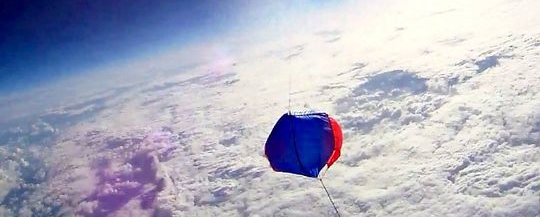(English below)
Zaplanowany po raz pierwszy w 2014 r., w 2020 r. wreszcie doczeka się realizacji – pomysł „przywrócenia” TRCN, ale w stratosferze, tam, gdzie nie istnieją ograniczenia mechaniczne na wysokości anten, a osiągnięty zasięg może być gigantyczny.
Na 12 września 2020 r. zaplanowano start balonu stratosferycznego z lotniska Politechniki Warszawskiej Przasnysz-Sierakowo w celu wykonania badań atmosfery – pomiaru promieniowania UV, wykonania nagrań kamerą szybkoklatkową oraz przeprowadzenia eksperymentu indukcyjnego na częstotliwości 14.2 kHz przy użyciu specjalnego systemu antenowego.
System indukcyjny wykorzystuje zmodyfikowany nadajnik długofalowy (emisja A1, niekluczowana) z projektu GLACiER Politechniki Warszawskiej, zrealizowanego w ramach programu IGLUNA – a Habitat in Ice (ESA_Lab / Swiss Space Center). Moc nadajnika, ze względu na odgórne ograniczenia emisyjne dla tego rodzaju urządzeń indukcyjnych, nie przekroczy kilku watów. System antenowy jest centralnie zasilanym poprzez transformator antenowy (35:1) dipolem z elementami pojemnościowymi (Hertza) i górną częścią w formie pionowej, osiowej cewki. Długość elektryczna to między 400 a 500 m przy długości całego systemu 210 m. Antena jest wyposażona w metalizowane reflektory radarowe.
Cała misja balonowa wykorzysta do nawigacji częstotliwości 144.8 MHz (jako SP5AXL) oraz 868 MHz (w ramach systemu firmy LoVo). Informacje o locie będą zawczasu dostępne w NOTAM (EPWW).
Planowany start balonu (nawet, jeśli na niebie będzie pełno „ołowianych” chmur) o godzinie 12.00 UTC (14.00 CEST, czasu lokalnego). Eksperyment 14.2 kHz zostanie uruchomiony na ziemi, z anteną początkowo złożoną w harmonię. Planowany całkowity czas lotu to 3 h – około godziny 13.30-14.00 UTC / 15.30-16.00 CEST planowane jest osiągnięcie maksymalnego pułapu 30 km n.p.m.
Jak można pomóc przy eksperymencie? Rejestrując, ile się da! Każdy parametr jest cenny – od widma/zrzutu ekranu z widmem, przez natężenia pola EM, SNR i szerokość pasma, po zmiany natężenia pola EM w czasie. Zebrane dane można przesyłać na nasz adres e-mail: stowarzyszenie@radiostacjababice.org. W dniu startu planujemy przesyłać aktualizacje nt. startu, lotu i eksperymentu przez naszą stronę na Facebooku: facebook.com/radiostacjababice.
Do usłyszenia!
***
Invented for the first time in 2014, in 2020 it will finally be implemented – the idea of “restoring” the TRCN, but in the stratosphere, where there are no mechanical limitations at the height of the antennas, and the achieved range can be gigantic.
The launch of a stratospheric balloon from the Przasnysz-Sierakowo airport of the Warsaw University of Technology is planned for September 12, 2020, in order to perform atmospheric tests – measuring UV radiation, recording the cloudy surroundings with a high-speed camera and conducting an inductive experiment at 14.2 kHz using a special antenna system.
The inductive system uses a modified long-wave transmitter (A1 emission, unkeyed) from the GLACiER project of the Warsaw University of Technology, implemented as part of the IGLUNA – a Habitat in Ice programme (ESA_Lab / Swiss Space Center). The power of the transmitter, due to the emission limits for this type of inductive devices, shall not exceed a few watts. The antenna system is a centrally fed (35: 1) dipole with capacitive (Hertzian) elements and a vertical axial coil. The electrical length is between 400 and 500 m, with a total system length of 210 m. The antenna is equipped with metalized radar reflectors.
The entire balloon mission will use 144.8 MHz (as SP5AXL) and 868 MHz (as part of the LoVo system) for navigation. Flight information will be available in advance in NOTAM (EPWW).
Planned balloon launch (even if the sky is full of ‘lead’ clouds) at 12.00 UTC (14.00 CEST, local time). The 14.2kHz experiment will be switched on on the ground, with the antenna initially folded in harmony. The predicted total flight time is 3 hours – around 13.30-14.00 UTC / 15.30-16.00 CEST it is planned to reach the maximum altitude of 30 km above sea level.
How can you help with the experiment? By recording as much as possible! Every parameter is valuable – from the spectrum / screenshot with the spectrum, to the EM field strengths, SNR and bandwidth, to the change of the EM field strength over time. The collected data can be sent to our e-mail address: stowarzyszenie@radiostacjababice.org. On the day of launch, we plan to post updates on the launch, flight and the experiment itself via our Facebook page: facebook.com/radiostacjababice.
Stay tuned!

